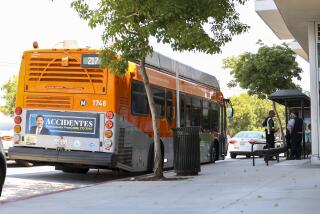Commentary : On the Wrong Track With Amtrak
U.S. Sen. Pete Wilson and others recently took sides on the Amtrak funding debate in a story in your Orange County edition. Public debate on such an important issue is certainly in the public interest. However, for the debate to be useful, the public must be given all of the facts supporting both sides of the argument. Therefore, I offer the following facts that I believe support a decision to continue adequate funding for Amtrak.
Fact 1: The people who benefit most from Amtrak are not the middle- and upper-income passengers but the 46% of our long-distance riders who have incomes of $20,000 and less; or the 36% of our long-distance riders who are elderly; or the people in the small communities for which Amtrak is the only mode of public transportation available.
Fact 2: Last year, when the Administration suggested that the private sector would buy some of Amtrak’s more “profitable” routes, all it heard was eerie silence. No one has come forward with an offer for the Northeast Corridor, Amtrak’s best-performing route, where the fixed costs exceed revenues by some $250 million. Nor has any state offered to pick up the full cost of operating any of Amtrak’s trains. Transportation Secretary Elizabeth Hanford Dole testified before the House Commerce Committee last spring thatthe Department of Transportation could not find anyone interested in operating intercity rail passenger service.
Fact 3: The Los Angeles-San Diego route, which has seen extraordinary ridership and revenue growth in the last several years, is not owned by Amtrak, but by the Santa Fe Railroad. Acting San Diego Mayor Ed Struiksma’s desire to purchase the trackage is not dependent on the elimination of Amtrak. Rather, he and the Metropolitan Transit Development Board would have to negotiate with the Santa Fe.
Fact 4: The elimination of Amtrak’s subsidy would contribute little to the reduction of the deficit, because Amtrak’s federal funding represents only three-tenths of one percent of the $180-billion deficit. Amtrak is already contributing to the deficit reduction effort by becoming more self-sufficient and asking less from the government each year. Since 1981, federal outlays for Amtrak have decreased 19%, while total federal outlays have increased 44%.
Fact 5: At the same time that Amtrak’s need for federal funding has decreased, ridership and passenger miles have increased. This means that since 1975 the number of passenger miles per dollar of federal support has increased by 155%. Taxpayers are getting more value for their dollar.
Fact 6: Amtrak is not the only mode that requires federal support. Billions of dollars, over and above user fees, is spent each year on the air traffic control system, highway construction and maintenance. The beneficiaries are obviously the airlines, but companies and others who, unlike Amtrak, are not required to openly request funding each year and include the amount in their financial reports.
The irony in Sen. Wilson’s determination to “wipe out” the Amtrak subsidy is that Amtrak has never been in better shape--financially and operationally--and our performance is especially good in California. Ridership on the San Diegan route increased 17.7% in the first quarter of fiscal 1986 over the same period in 1985. The Los Angeles-Seattle “Coast Starlight,” one of Amtrak’s most popular long-distance trains, saw a 10.6% increase in the first quarter. Ridership also increased on all other Amtrak routes in the state.
Systemwide in the first quarter, total revenues increased by 8.4% and passenger miles grew by 12.4%. This trend builds on our excellent performance in the last fiscal year, when revenues were up 8.8% to more than $825 million and passenger miles grew by 6% to 4.8 billion.
I believe we can continue these positive performance trends while we continue to need less federal support each year. However, the total elimination of federal funding would mean bankruptcy for Amtrak and the loss of 24,000 jobs. The federal government probably would be required to pay in excess of $2 billion in labor protection to those employees.
Furthermore, it would be the end of intercity rail passenger service in this country. I am doubtful that the system could ever be rebuilt, because once the Amtrak organization is destroyed and its assets liquidated, the cost to replace it would be prohibitive.
More to Read
Sign up for Essential California
The most important California stories and recommendations in your inbox every morning.
You may occasionally receive promotional content from the Los Angeles Times.










